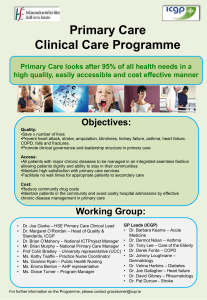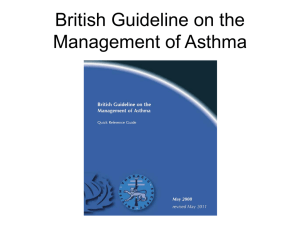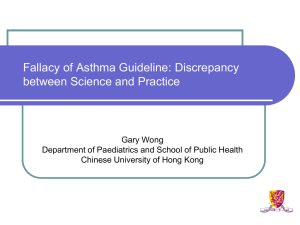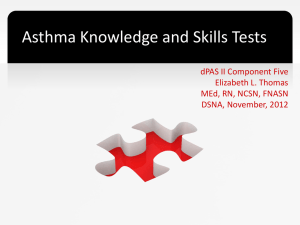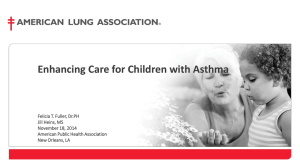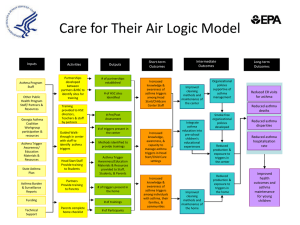Pediatric Asthma
advertisement
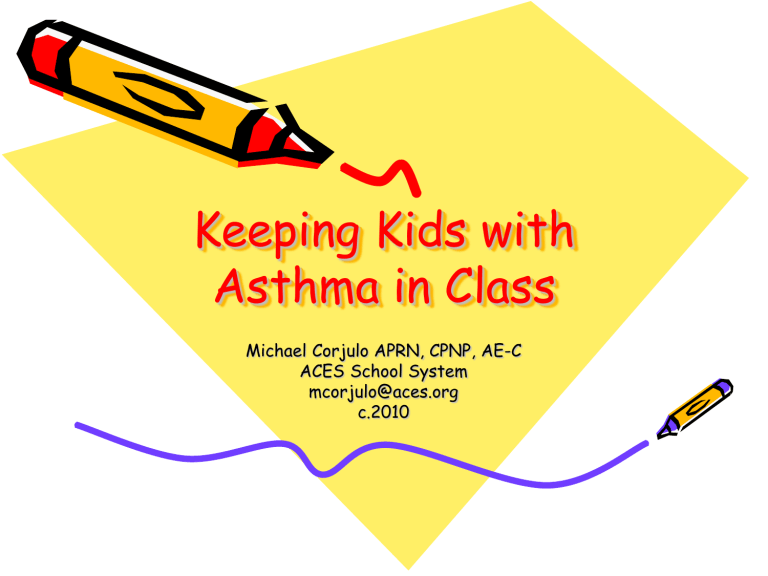
Keeping Kids with Asthma in Class Michael Corjulo APRN, CPNP, AE-C ACES School System mcorjulo@aces.org c.2010 Objectives • Demonstrate an understanding of common barriers to successful asthma management for students in school • Identify collaborative strategies that support academic achievement by improving asthma control for students • Discuss initiatives to improve asthma management and control. Pre-Test Survey Question • On a scale of 1 to 10 – 1 being not at all – 10 being totally satisfied • How satisfied are you with the overall asthma management of the students in your school? • Write down your biggest issue or barrier Pediatric Asthma Based on the National Institutes of Health 2007 Expert Panel Report 3 National Asthma Education and Prevention Program (NAEPP) Raise the Bar! Asthma is the #1 cause of avoidable hospitalization • Children hospitalized with asthma very often represent a failure of ambulatory care management NAEPP: Components of Asthma Management PHARMACOLOGIC THERAPY Request for Medication Refill EDUCATION FOR PARTNERSHIP WITH FAMILIES ASSESSMENT & MONITORING Symptoms Medication Use TRIGGERS & ALLERGENS Exposure Avoidance Interventions Based onThe Expert Panel Report 2: Guidelines for the Diagnosis and Management of Asthma (NHLBI, 1997) Corjulo, M (2005). Telephone triage for asthma medication refills, Pediatric Nursing, 1(2), 116-120. Asthma Management 2010 Assessment Symptoms Risk / Impairment Control Treatment: Triggers Medication Education Assessment The Big Picture • How many times would a student needing asthma treatment be seen by the nurse in one day? 1. 2. 3. 4. 5. Assess the problem and treat Re-assess If not completely resolved – re-assess again If having to treat again Re-assess again » Can’t send a student with acute symptoms home on a bus! The Big Picture • If this happened everyday – How many visits would this student make to the nurse’s office in one week? • Or if symptoms occur 3x/week • How many in a month? • a quarter? • a year? The Big Picture • How much time is that out of the classroom, not learning??? – What else is the student not doing because of their asthma? • How much of this is avoidable? » So what are we going to do about it? Overcoming Asthma Management Barriers … in school …..and beyond The Asthma Action Plan Bridge CT DPH AAP Asthma Action Plan: Home, Play, School, & Travel The ACES AAP Name: Birth Date: Date: Fax #: Provider Phone #: Parent/Guardian Phone #s: □ pets □mold □ dust □pollen □colds/viruses □exercise □seasons: other: Severity: □ Severe Persistent □ Moderate Persistent □ Mild Persistent □Intermittent Important! Things that make your asthma worse (Triggers): X smoke GO – You’re Doing Well! You have all of these: Breathing is good No cough or wheeze Sleep through the night Can work and play CAUTION – Slow Down! CAUTION – Slow Down! You have any of these: First signs of a cold Exposure to known trigger Cough Wheeze Tight chest Coughing at night DANGER – Get Help! Your Asthma is getting Coughing worseatfast if you have night any of these: Medicine is not helping Breathing is hard and fast Nose opens wide Can’t talk well Getting nervous USE THESE MEDICINES EVERYDAY TO PREVENT SYMPTOMS MEDICINE HOW MUCH HOW OFTEN/WHEN Inhalers work better with Spacers MEDICINE 1. Continue with Green Zone Medicine and ADD: CONTINUE WITH GREEN ZONE MEDICINE AND ADD: Albuterol / Xopenex HOW MUCH 2 puffs or 1 vial HOW OFTEN/WHEN Every _____ Hours □ Before Exercise as needed CALL our Office if: You need your ALBUTEROL or XOPENEX SOONER than EVERY 4 HOURS or EVERY 4 HOURS for MORE than 2 days or any questions or concerns TAKE THESE MEDICINES AND CALL YOUR PROVIDER NOW CALL YOUR HEALTH CARE PROVIDER FOR HELP, ESPECIALLY IF YOU NEED MEDICINE HOW MUCH OFTEN/WHEN YOUR ALBUTEROL OR XOPENEX SOONER THAN 4 HOURSHOW OR EVERY 4 HOURS FOR MORE THAN 2 DAYS Albuterol / Xopenex NOW! Get help from a doctor now! Do not be afraid of causing a fuss. It’s important! If you cannot contact your doctor, go directly to the emergency room or call 911 and bring this form with you. DO NOT WAIT. Provider Signature ______________________________________________________ Date______________________ I give permission to the school nurse and my child’s health care provider to exchange information to assist in my child’s asthma management. Parent/guardian signature __________________________________________________ 3/09 Date____________________ Make an appointment with your primary care provider within two days of an ED visit, hospitalization, or for ANY problem or question with asthma * Bring asthma meds and spacer to all visits The CMG AAP Asthma Action Plan: Home, Play, Travel, and School Name: Children’s Medical Group 299 Washington Avenue Phone #: 288-4288 Date: Fax #: 288-1566 Hamden, CT 06518 Provider: Your Asthma Triggers / Allergies: X smoke □ pets □mold □ dust □pollen □ grass □colds/viruses □exercise □seasons: other: Severity: □ Severe Persistent □ Moderate Persistent □ Mild Persistent □Intermittent GO – You’re Doing Well! Inhalers work better with Spacers You have all of these: Breathing is good No cough or wheeze Sleep through the night Can work and play USE THESE MEDICINES EVERYDAY TO PREVENT SYMPTOMS MEDICINE HOW MUCH 1. _____ puffs AM / PM 2. _____ squirt(s) each nostril AM / PM 3. AM / PM 4. AM / PM CAUTION – Slow Down! You have any these: CAUTION – of Slow Down! First signs of a cold Exposure to known trigger Cough Wheeze Tight chest Coughing at night DANGER – Get Coughing at night Your Asthma is CONTINUE WITH GREEN ZONE MEDICINE AND ADD: MEDICINE 1. HOW MUCH HOW OFTEN/WHEN CONTINUE WITH GREEN ZONE MEDICINE AND ADD: Albuterol / Xopenex 2 puffs or 1 vial Every _____ Hours □ Before Exercise as needed 2. Inhalers work better with Spacers CALL our Office if: You need your ALBUTEROL or XOPENEX SOONER than EVERY 4 HOURS or EVERY 4 HOURS for MORE than 2 days or any questions or concerns Help! getting worse fast: Medicine is not helping Breathing is hard and fast Nose opens wide Can’t talk well Getting nervous HOW OFTEN/WHEN TAKE THESE MEDICINES AND CALL YOUR MEDICINE HOW MUCH Albuterol / Xopenex 4 puffs or 1 vial PROVIDER NOW HOW OFTEN/WHEN NOW! & Call the office OR Get help from a doctor now! Do not be afraid of causing a fuss. It’s important! If you cannot contact your doctor, go directly to the emergency room or call 911 and bring this form with you. DO NOT WAIT. Provider Signature _______________________________________________ Date_____________________ I give permission to the school nurse and my child’s health care provider to exchange information to assist in my child’s asthma management. Parent/guardian signature __________________________________________________ Date____________________ Make an appointment with your primary care provider within two days of an ED visit, hospitalization, or for ANY problem or question with asthma * Bring asthma meds and spacer to all visits Next Visit:____________________ (At least every 6 months if doing well) NHLBI AAP Don’t Have an Action Plan • Rely on the student’s recollection of his/her asthma plan Have an Action Plan • Can review written plan with student – May not know the names of meds or when they should be used – Have to call the parent, who also may not be sure – Makes having a creditable collaboration with the provider very difficult – Seldom results in improved asthma management – Discuss control medication use • Consistency • Issues – Identify knowledge gaps – Review plan written by Provider with parent – Can result in an office visit, prescription refill, or other positive action The Big Picture • Not having an Asthma Action Plan can be like trying to meet IEP goals that are not written OR • Determining if immunizations are up to date without an immunization record Case Example • 13 y.o. who has had 22 doses of albuterol in his first 37 days of school – Including 1 known ED visit • Can you call his PCP without a HIPAA compliant release of information? HIPPA, FERPA, & ASTHMA • Yes. The Privacy Rule allows those doctors, nurses, hospitals, laboratory technicians, and other health care providers that are covered entities to use or disclose protected health information, such as Xrays, laboratory and pathology reports, diagnoses, and other medical information for treatment purposes without the patient’s authorization. This includes sharing the information to consult with other providers, including providers who are not covered entities, to treat a different patient, or to refer the patient. See 45 CFR 164.506. Case Study F/U • His PCP contacts the family, schedules an appointment for an asthma assessment: – Started on a daily control med – An Asthma Action Plan copy is sent to school (as requested) • How will that have a positive impact? » BTW, that was approximately 89 visits to the nurse’s office in that 37 days of school The Action Plan Request Letter Dear Fellow Health Care Provider, Enclosed / attached is a blank Asthma Action Plan for your patient. Please return or fax a copy back to the attention of the school nurse. This or any 3 zone action plan will be very helpful, so if you already have an updated action plan for this student, a copy of that would be appreciated… • Thank you for making the effort to strengthen our collaborative relationship and improve the asthma care of children and adolescents in our community. • Results? TEMS (800 students) • 12/09 – 74 students with asthma medication orders – 9 AAP (12%) • Letter mailed to each student’s provider • 3/10 – 48 AAP (65%) The “Buy In” Who’s buying in to what? The Elephant in the Room Compliance EPR 3 Component 2 • Education for a Partnership in Asthma Care • Concepts found in: – Chronic Care Models – Family-Centered Care – Medical Home The Chronic Care Model • Use of explicit plans and protocols • Practice Redesign (sick model doesn’t work) • Patient Education (self-management behavior change, on-going support for patients who participate) • An “expert system” (decision support, provider education, consultation) • Supportive information systems (registries, outcomes, feedback, care planning) • Which of the following concepts is NOT found within a Family-Centered Care framework? – – – – Professional as expert model Screening for non-compliance Create opportunities to make informed choices Social work consult for all difficult patients and families Family/Professional Collaboration • Seek mutually-acceptable plans & goals vs. Getting hung-up on COMPLIANCE ! Assess & Negotiate: Why is this plan not working? Medication History • What do assessing for medication “compliance” and 3rd grade math have in common? • 7 x 2 = 14 • Or does it? EPR 3 Component 2 • Asthma self-management is essential • Self-management education should be integrated into all aspects of care • Involve all members of the health care team • Occur at all points of care: » » » » » » Primary Care Specialty Care Home School Acute Care / ED Where Else? Assessing Asthma Control Assessing Asthma Control and Adjusting Therapy in Children 5 to 11 Years of Age Not Well Controlled Very Poorly Controlled >2 days/week or multiple times on ≤2 days/week Throughout the day ≤1x/month ≥2x/month ≥2x/week Interference with normal activity None Some limitation Extremely limited SABA use for symptom control (not prevention of EIB) 2 days/week >2 days/week Several times per day 60%-80% predicted/ personal best 75%-80% <60% predicted/ personal best <75% Components of Control Symptoms Nighttime awakenings Impairment Lung function • FEV1 or peak flow Risk • FEV1/FVC Exacerbations requiring oral systemic corticosteroids Reduction in lung growth Treatment-related adverse effects Recommended Action for Treatment Well Controlled ≤2 days/week but not more than once on each day >80% predicted/ personal best >80% 0-1/year ≥2/year Consider severity and interval since last exacerbation Evaluation requires long-term follow-up Medication side effects can vary in intensity from none to very troublesome and worrisome. The level of intensity does not correlate to specific levels of control but should be considered in the overall assessment of risk • Maintain current step • Step up at least 1 step and • Consider short course of • Regular follow-up every • Reevaluate in 2 to oral systemic corticosteroids 1 to 6 months 6 weeks • Step up 1 or 2 steps, and • Consider step down if • For side effects, consider • Reevaluate in 2 weeks well controlled for at alternative treatment • For side effects, consider least 3 months options alternative treatment options Adapted from National Asthma Education and Prevention Program. Expert Panel Report 3: Guidelines for the Diagnosis and Management of Asthma (EPR-3 2007). U.S. Department of Health and Human Services. Available at: http://www.nhlbi.nih.gov/guidelines/asthma/asthgdln.pdf. Accessed August 29, 2007. Assessing Asthma Control and Adjusting Therapy in Youths ≥12 Years of Age and Adults Components of Control Impairment Very Poorly Controlled Symptoms ≤2 days/week >2 days/week Throughout the day Nighttime awakenings ≤2x/month 1-3x/week ≥4x/week Interference with normal activity None Some limitation Extremely limited SABA use for symptom control (not prevention of EIB) ≤2 days/week >2 days/week Several times per day FEV1 or peak flow >80% predicted/ personal best 60%-80% predicted/ personal best <60% predicted/ personal best Validated questionnaires ATAQ ACQ ACT Exacerbations requiring oral systemic corticosteroids Risk Well Controlled Not Well Controlled 0 1-2 3-4 ≤0.75 ≥1.5 N/A ≥20 16-19 ≤15 0-1/year ≥2/year Consider severity and interval since last exacerbation Progressive loss of lung function Evaluation requires long-term follow-up Treatment-related adverse effects Medication side effects can vary in intensity from none to very troublesome and worrisome. The level of intensity does not correlate to specific levels of control but should be considered in the overall assessment of risk • Maintain current step • Step up 1 step and • Consider short course of oral systemic corticosteroids • Regular follow-ups • Reevaluate in 2 to 6 every 1-6 months to weeks • Step up 1-2 steps, and maintain control • For side effects, consider • Reevaluate in 2 weeks • Consider step down if alternative treatment • For side effects, consider well controlled for at options alternative treatment options least 3 months Recommended Action for Treatment Adapted from National Asthma Education and Prevention Program. Expert Panel Report 3: Guidelines for the Diagnosis and Management of Asthma (EPR-3 2007). U.S. Department of Health and Human Services. Available at: http://www.nhlbi.nih.gov/guidelines/asthma/asthgdln.pdf. Accessed August 29, 2007. #1 • Appreciate the Chronic & Inflammatory nature of the disease A Key to Control Inhaled Steroids have become the pharmacological key to long-term asthma control. Daily use can: Minimize the need for systemic steroids Decrease ED use and Hospitalization Decrease the potential for symptoms & acute exacerbations Improve exercise and activity tolerance Classifying Asthma Severity and Initiating Treatment in Youths ≥12 Years of Age and Adults Persistent Components of Severity Impairment Normal FEV1/FVC: 8-19 yr 85% 20-39 yr 80% 40-59 yr 75% 60-80 yr 70% Mild Moderate Severe Symptoms 2 days/week Nighttime awakenings 2x/month 3-4x/month >1x/week but not nightly Often 7x/week 2 days/week >2 days/week but not daily and not more than 1x on any day Daily Several times per day None Minor limitation Some limitation Extremely limited • FEV1 >80% predicted • FEV1/FVC normal • FEV1 >60% but <80% predicted • FEV1/FVC reduced 5% • FEV1 <60% predicted • FEV1/FVC reduced >5% SABA use for symptom control (not prevention of EIB) Interference with normal activity Lung Function Risk Intermittent Exacerbations requiring oral systemic corticosteroids • Normal FEV1 between exacerbations • FEV1 >80% predicted • FEV1/FVC normal Daily Throughout the day ≥2/year Consider severity and interval since last exacerbation Frequency and severity may fluctuate over time for patients in any severity category 0-1/year Relative annual risk of exacerbations may be related to FEV1 Step 1 Recommended Step for Initiating Treatment >2 days/week but not daily Step 2 Step 3 Step 4 or 5 and consider short course of oral systemic corticosteroids In 2 to 6 weeks, evaluate level of asthma control that is achieved and adjust therapy accordingly EIB = exercise-induced bronchospasm; FEV1 = forced expiratory volume in one second; FVC = forced vital capacity. Adapted from National Asthma Education and Prevention Program. Expert Panel Report 3: Guidelines for the Diagnosis and Management of Asthma (EPR-3 2007). U.S. Department of Health and Human Services. Available at: http://www.nhlbi.nih.gov/guidelines/asthma/asthgdln.pdf. Accessed August 29, 2007. Asthma Control Report: For Family and Health Care Provider Student/ Child’s Name: Age: Home Town/City: Grade: School: Date: PART 1 School Nurse or asthma educator can assist the student or family in understanding the questions in a developmentally and culturally appropriate manner in order to obtain objective and accurate information. Circle the correct response YES 1. Does your asthma get in the way or stop you from doing an activity in school, at home, during play or a sport? If YES: Rarely (less than once a month) Sometimes (less than once a week) NO Frequently (at least once a week) 2. In the past 4 weeks, how many times did you wheeze, cough, feel tight in the chest, or have trouble breathing? Rarely (2 or less times a month) Sometimes (3 – 8 times a month) Frequently ( at least 3 times a week) 3. In the past 4 weeks, how many times did your asthma wake you up at night or make it hard to sleep? Rarely (2 or less times a month) Sometimes (2 – 4 times a month) Frequently ( at least 4 times a month) 4. In the past 4 weeks, how many times did you have to use your rescue inhaler or nebulizer (albuterol or xopenex)? Rarely (2 or less times a month) Sometimes (3 – 8 times a month) Frequently ( at least 3 times a week) 5. How many days of school have you missed this year because of your asthma? PART 2 On a scale of 1 – 10: “1 being your asthma never really bothers you; and 10 being your asthma is so bad you should be in the hospital” , What is your asthma number? Yes No Do you have a spacer to use with your inhaler? o If yes, how often do you use it? Never Sometimes Always Is there an Asthma Action Plan for this student at the school or in the home? Yes No: (blank enclosed) o If yes, most recent date: PART 3 Known frequency of Albuterol or Xopenex use in: school or home (circle one). Can tally to keep track (IIII II = 7) Sept Oct Nov Dec Jan Feb March April May June Planned (Pre-Ex) Acute Sx’s Any additional information you think would be helpful for this student’s health care provider or family to know: Nurse or Assessor’s Printed Name: Phone Number: July August ACES Student Asthma Control Report: For Family and Health Care Provider Part B: Compare how the student’s asthma control rates according to the 2007 National Asthma Guidelines In the past 4 weeks: Well Controlled Not Well Controlled Very Poorly Controlled 1. How many times did your asthma get in the way or stop you from doing an activity in school, at home, during play or a sport? None Sometimes Frequently 2. How many times did you wheeze, cough, feel tight in the chest, or have trouble breathing? 2 or less 3-8 Every day 3. How many times did your asthma wake you up at night or make it hard to sleep? 2 or less 2-4 More than 4 4. How many times did you have to use your rescue inhaler or nebulizer (albuterol or xopenex)? 8 or less More than 8 Answers in these boxes should indicate good asthma control Any answers in these sections could indicate the need for an asthma visit Usually every day Any answers in these boxes indicates the need to call for an asthma visit Your Quality Asthma Management Checklist: Is your asthma well controlled? Have you had a planned asthma visit (not for an acute attack or exacerbation) in the past 6 months? Are you sure that you know what your asthma allergies are? Do you know how to avoid your asthma triggers and allergies? Do you have a copy of an Asthma Action Plan that you understand and know how to use? If you are able to check off the whole list – Great! If not, or if you have any questions about asthma or medications, call your provider for an asthma visit This project is in accordance with the CT Department of Public Health Collaborative Effort for Addressing Asthma in Connecticut: 2009-2014; The Yale New Haven Community Medical Group Pediatric Asthma Sub-Committee; and the ACES Students with Asthma Quality Improvement Program Any questions, please contact: The Missing Links Broad Categories of Why Asthma Management Fails Diagnosis Treatment Fixing what doesn’t work ? • MDI’s work better with Spacers! • You should request a spacer to use with all MDI orders » Stop Laughing (again) Teaching Moment: Why a Spacer Demonstrate what a puff of an MDI looks like in the air and point out how hard it is to make sure it is not squirted on the tongue or back of throat and how hard it is to breathe in at exactly the right second So Jimmy, do you have a spacer to use with that inhaler? Why a Spacer: Sample Dialogue • When discussing the use of an inhaler without a spacer ask: “Did you ever puff it so it felt like you got it down in your lungs…. (yes)…. “Well did you ever miss a little and get it on your tongue or the back of your throat” …(yes)…. “that’s medicine that doesn’t do any good, it doesn’t help your asthma” Useful Analogies: Inhaled Asthma Meds only work if you get them in your lungs • Like taking 2 Tylenol for your headache and throwing one over your shoulder You’re still going to have a headache • Like eating pizza or ice cream and spitting it out or like throwing popcorn up in the air and missing it You’re still going to be hungry • Identifying and avoiding allergens & triggers is at least as important as medication • How much of the $12 billion that asthma costs can we save if we stop throwing fuel on the fire? Allergy / Trigger Medication The Chronic Inflammation of Asthma Medication Allergy / Trigger The Chronic Inflammation of Asthma Keys to Successful Asthma Management for Students • Just call it ASTHMA! – Need a diagnosis • Assess Control • Obtain an Asthma Action Plan – Use it to communicate and educate • Focus on inhaled medication technique • Improve environmental interventions »Including your school’s IAQ Your IAQ Program • Does your school/district have one • How active is it? • How involved are you in it? • Do you want to learn more about it? IAQ Contacts CT http://csiert.tfsiaq.com Karen_DeSimone@whps.org mcorjulo@aces.org Everywhere Else http://www.epa.gov/iaq/whereyoulive.html Sample Summary of Successful Asthma Programs and Initiatives in CT • In 2008 the ACES school system increased the number of Asthma Action Plans from 12 to 164 in one SY • The Yale Community Medical Group is standardizing asthma management with all Yale-affiliated PCPs • The CCMC based Easy Breathing Program has significantly improved the number of children diagnosed with asthma and decreased hospitalization • The DPH has regional programs that will do in-home asthma trigger evaluations and teaching – And they accept school nurse referrals Sample Summary of Successful Asthma Programs and Initiatives in CT • CT DPH has a lot of information about statewide initiatives and resources http://www.ct.gov/dph/cwp/view.asp?a=3137& q=387872 Home Schools ED & Hospitals Community Health Centers Community Educators and SBHC Communication T e c h n o l o g y The Primary Care Medical Home Model Coordination Pulmonologists and Allergists F u n d i n g Local Health Departments Home Care and VNA Post-Test

